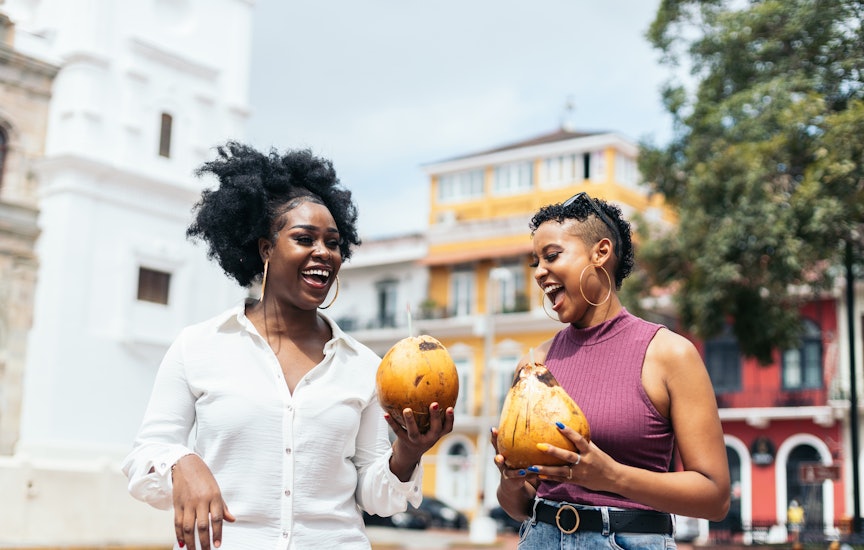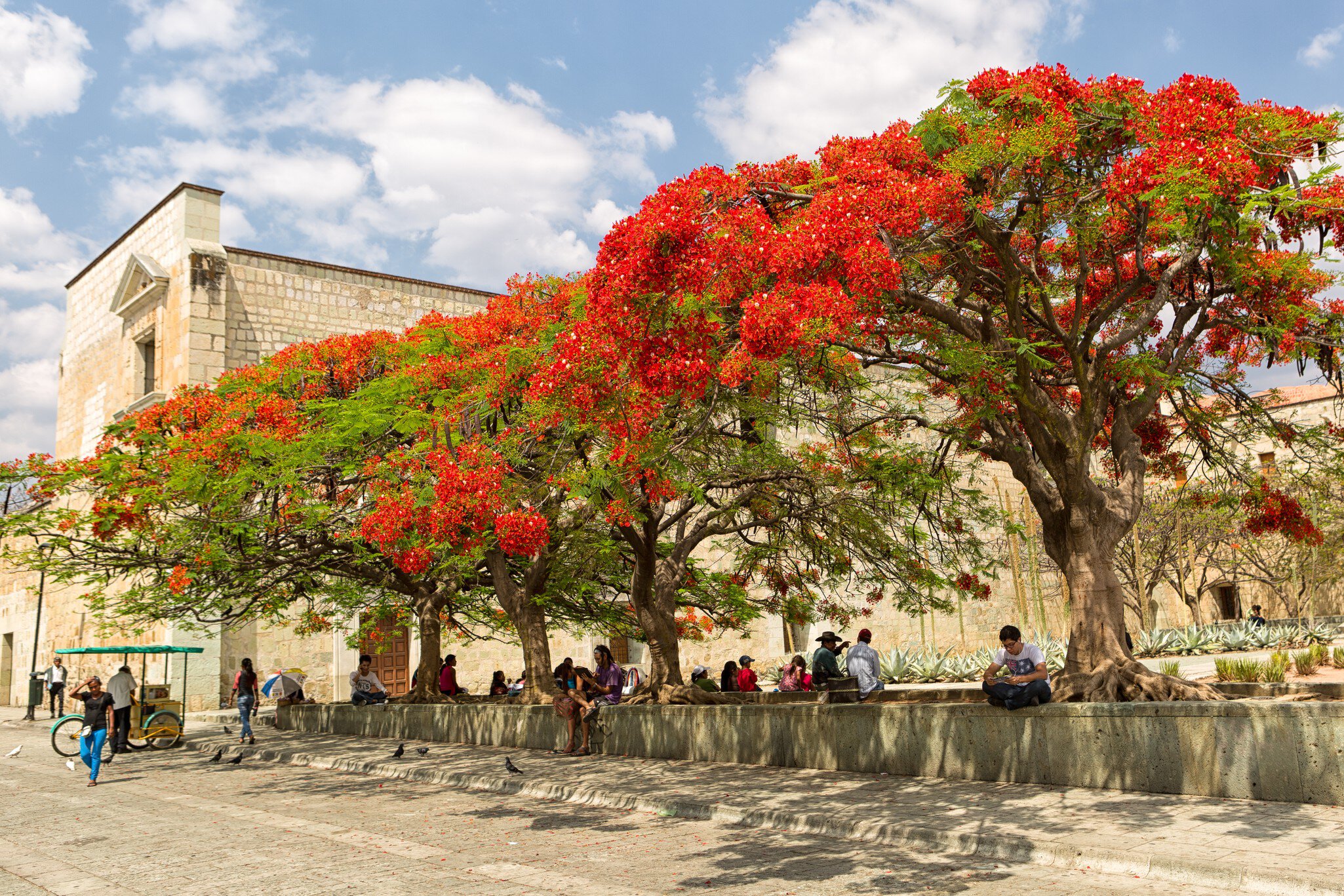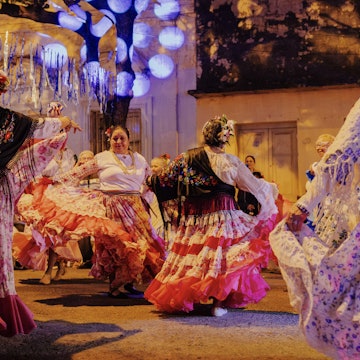

The local Sunday market in Tarabuco, Bolivia. el parajo lindo/Shutterstock
Ever had a llama tenderloin? If not, this is your chance, perhaps paired with a glass of Tarija wine. Bolivia's food is as diverse as its landscapes and population and you'll find new delicacies to sample in every town.
Markets are a good place to start, though the steaming pots of unfamiliar concoctions might test tremulous tastebuds. Freshly-blended fruit juices will no doubt become a daily habit, while high-altitude Yungas coffee is now available in a number of new cafes popping up around Bolivia.
The restaurant scene is thriving in Santa Cruz, Cochabamba and โ more than anywhere else โ La Paz, where you can sample contemporary takes on traditional drinks and dishes. No matter where you find yourself โ be it the tropics or the high Andes โ youโre bound to find colorful street snacks and elaborate meals making good use of the country's vast larder. These are some of the best things to eat and drink in Bolivia.

Warm up with mondongo chuquisaqueรฑo
Mondongo is ubiquitous across South America, the Caribbean and even parts of the Philippines. However, a traditional plate of mondongo in other countries is more of a thick corn-based stew, like Colombiaโs famous dish, whereas Boliviaโs version shares only the name.
Mondongo chuquisaqueรฑo is not a stew or a soup, but rather a dish made of pork loin and a variety of vegetables. Particularly popular in Sucre, Boliviaโs constitutional capital, it is usually a staple dish during holidays such as the Day of the Dead.
The pork is marinated and cooked in a sweet paprika sauce, along with potatoes, mote, onions, garlic, chili and turmeric. In Bolivia, mote is usually made from corn or sometimes fava beans cooked in their own husk, differentiating them from a husked grain called pelado that is common elsewhere in South America.
Where to try it: Order up a plate of comforting mondongo chuquisaqueรฑo at in Sucre.

Indulge in the comforting locro de gallina
Locro de gallina loosely translates as โhen soup.โ The main reason for this distinction is that pollo (chicken) typically refers to young chickens of either gender, while gallina (female) and gallos (male) refer to older, mature chickens.
Because gallinas are typically older, the meat is a little tougher. Pollo is usually baked, broiled and fried and served up as the main part of a dish, but gallina is cooked low and slow in stews and soups to soften the tougher texture. This scrumptious Bolivian soup is served with shredded pieces of chicken (although chefs usually prep the whole chicken with the bone), potatoes and maize corn.
The broth is seasoned with herbs, including coriander, oregano and cilantro, as well as sauteed onions and garlic. The addition of aji peppers gives the soup a slight kick that makes it hearty and flavorful, and it's often served with a piece of avocado and rice.
Where to try it: While locro de gallina can be enjoyed at almost any traditional Bolivian restaurant in La Paz or Santa Cruz, the best option is in Santa Cruz.
Experience traditional tโanta wawa
Tโanta wawa, also known as pan de wawa in Spanish, translates loosely to baby bread. This may sound like a slightly odd name for a dish, but it is actually one of Boliviaโs sweetest traditions. In ancient Peruvian and Bolivian culture, predating the arrival of the Spanish, native tribes would bake a sweet corn bread called sanku, which was intended as an offering to their deceased children.
In addition to traditional ingredients for bread, such as flour and perhaps a little sugar, tโanta wawa typically also contains nuts, seeds and dried fruits, and is decorated with a childlike face.
Where to try it: The markets near Plaza San Francisco in La Paz have some of the best places to taste this sweet (in every way) pastry.

Snack on salteรฑas
These ubiquitous yellow-orange turnovers are a staple mid-morning snack found across Bolivia. Smaller, stouter and sweeter than traditional empanadas, they often pair a protein (beef, pork or chicken) with olives, raisins and potatoes. The juiciness of the filling comes from added gelatin, and many connoisseurs add the Bolivian salsa llajua for an added kick. Expect a tasty film on your fingers and a warm glow in your belly.
Where to try it: in Potosรญ.
Spice up tea time with a cuรฑapรฉ or sonso de yuca
Take tea time to the next level with afternoon treats like cuรฑapรฉs. These cheesy yuca bread rolls can be found in many Bolivian cities, but are most common in the east, where they are sometimes known as chipรก (typically near the border with Paraguay).
Cuรฑapรฉs can become quite addictive, so if you develop a liking for them, youโll also want to try a sonso de yuca, which is a cheesy cassava bread thatโs often grilled on a big bamboo skewer over smoldering charcoal.
Where to try it: in Riberalta.

Taste the rainbow of Bolivian fruit juices
Bolivia packs a continentโs worth of topography into a relatively small package, which means you can find a massive array of fruits you may have never tried before. Fresh juices are one of the best ways to sample them, with common options including chirimoya (a custard apple), tumbo (the banana passionfruit) and tuna (which comes from the prickly pear cactus).
In the Amazon basin, you can also find plenty of asaรญ (the antioxidant-rich palm berry better known abroad as acai), which is used to make smoothies or bowls topped with fruits and grains.
Where to try it: In regional markets such as Santa Cruzโs Mercado Abasto.
Try k'alaphurka, the stone-heated soup
Where else can you sit back and watch as a server drops a hot volcanic rock into the middle of your soup? Such are the joys of eating k'alaphurka, one of the most famous dishes in the southern city of Potosรญ. Made from a base of corn flour, this stone-heated soup also includes potatoes, dried charque meat, ground ajรญ chili peppers and chachacoma leaves โ all served in a large earthen bowl (for obvious reasons!).
Where to try it: in Potosรญ.

Swirl wine or sip the brandy in Tarija
Some of the worldโs highest-altitude vineyards lie near the town of Tarija, which has seen major investments over the last decade in both wineries and more sophisticated, textured wines. Tannat is the star grape here, and producers such as and have gone head-to-head with winemakers from this red varietalโs homeland, France, in international competitions.
Meanwhile, the Muscat of Alexandria grape, which dominates Bolivian vineyards, goes into the pisco-like spirit singani, an eau-de-vie thatโs mixed with ginger ale or lemon soda for the popular cocktail chuflay.
Where to try it: Beyond Tarija, the best place for singani or wine is Gustu in La Paz.
Try charquekan, the meal that fueled the Incas
The hearty Aymara dish of charquekan, common in southwestern Bolivia, is made by rehydrating dried llama meat. This creates a stringy, salty protein that is then draped over colorful native potatoes (or large corn kernels) and served with cheese and boiled eggs.
Where to try it: in Oruro.

Taste the bitter kick of coca leaves
Coca leaves are sacred to many Indigenous groups in the Andes of South America, where they are used for various ceremonial and medicinal purposes. Despite their infamy abroad as the base ingredient for cocaine, as well as the original Coca-Cola, they are a staple across Bolivia, flavoring everything from mildly stimulating liqueurs to bitter IPAs.
Hotels in destinations such as the Salar de Uyuni or Lake Titicaca often serve guests an infusion of dried coca leaves, called mate de coca, which is the most natural way to combat the effects of altitude.
Where to try it: Hotels in southwestern Bolivia or on trekking tours in the Andes.
Fill up on a pique a lo macho
This hangover killer is a heaping mess of beef, sausage, boiled eggs, gravy, peppers and onions โ all served over french fries. Most Bolivians wouldnโt order a pique a lo macho for one. It is โ like the similarly carb-heavy plate silpancho (schnitzel-style meat over a fried egg, rice and potatoes) โ typically shared among groups of friends.
Where to try it: in Cochabamba.

Warm up on a cold altiplano morning with api de maรญz morado
This hot drink made with ground purple corn, cinnamon, sugar and cloves is a popular breakfast item in the altiplano. Thick and hearty, itโs often accompanied by fried donut-like pastries called buรฑuelos. Consume the two together, and you could probably skip lunch.
Where to try it: The markets of La Paz, Oruro, Potosรญ and Cochabamba.
Fill up on humintas
Made from ground corn steamed inside corn leaves, similar to a Mexican tamale, humitnas are a wonderful mid-day treat. These tasty little snacks are popular across Bolivia and in several neighboring countries, though they are known as "humitas" elsewhere.
The recipe calls for finely ground corn โ often milled in industrialized areas or traditionally hand-ground in more rural regions. It is commonly eaten throughout the country, but the humintas cooked and sold in Tupiza are especially popular. They are cooked inside corn husks and typically contain a little lard, cheese and seasonings of choice. In Tupiza, the recipe usually includes basil and goat cheese, making it more robust and flavorful.
Where to try it: Humintas are somewhat ubiquitous across Bolivia and can be found at almost any street vendor.

Celebrate Easter with sopa de teโqo and biscocho de Semana Santa
During Easter week, Bolivians eat sopa de teโqo (vegetable soup) and biscocho de Semana Santa (round, flat biscuits). Though the name may leave you expecting a bowl of veggie delights, sopa de teโqo actually contains quite a lot of meat, with some recipes including a blend of beef, pork and chicken. It also has many rich veggies, like potatoes, achojcha, green peppers, that give it a vibrant taste.
Biscocho de Semana Santa is somewhat reminiscent of a scone, usually containing raisins and other dried fruits.
Where to try it: in Cochabamba is a great place to try these celebratory dishes.
Vegetarians, vegans and other special diets
Vegetarian options are on the rise in Bolivia, but meat still dominates most menus, particularly in the countryside where some chefs will be unfamiliar with vegetarian, vegan or special diets. However, many Bolivian dishes are naturally vegan, including the meatless version of sopa de manรญ (a protein-packed soup made of ground peanuts and noodles) or humintas (ground corn steamed inside corn leaves, similar to a Mexican tamale).
Itโs also common to find vegetarian plates based around yuca, potatoes or the supergrain quinoa. Both vegans and vegetarians will find the most options in La Paz, where the plant-based fine dining restaurant has been instrumental in creating innovative meatless versions of many traditional dishes.

Plan with a local












